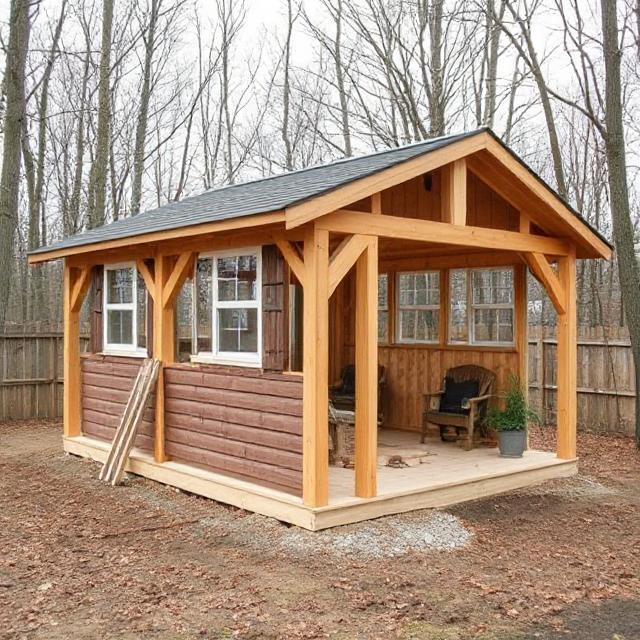Introduction: Why the Shed Base Matters
Most people who build a shed focus on the upper structure—the walls, roof, and doors. But any shed’s strength lies below. The shed base provides stability, balance, and elasticity, keeping the structure upright and functioning for years.
In areas where the weather can be unpredictable—whether icy winter, torrential downpour, scorching sun, or raging gales—a standard Shed Base can prove inadequate. That is where the concept of a weather-sensitive shed base has become so important. These foundations are designed specifically to adjust, react, and accommodate changing environmental conditions so that your shed is secure and stable throughout the year.
Why Traditional Shed Foundations Fail
Traditional shed foundations such as concrete slabs, paving slabs, or gravel layers can function in mild weather but will fail in harsh conditions. In cold climates, ground water freezes and expands into ice, exerting upward pressure against parts of the concrete—a phenomenon known as frost heave. Over time, this can result in the foundation cracking and inclining the shed.
In rainy or flood conditions, poor drainage allows water to accumulate under the building. The trapped moisture causes corrosion, mold, and wood rotting, weakening the foundation. In hot and dry locations, the ground under can erode and shift, causing instability. And in windy locations, an unanchored, light shed can shift or even be blown off its foundation.
A weather-adaptive shed base is designed to address these problems with the assistance of more sophisticated engineering and materials that adapt to shifting weather conditions.
How A Weather-Adaptive Shed Base Functions: The Adaptation Advantage
A weather-adaptive shed base is not merely a surface for your shed—but an adaptive system that reacts to its environment. Its design prioritizes flexibility, drainage, insulation, and safe anchoring.
At lower temperatures, flexible foundations are built with deep footings below the frost line, keeping the building firm even when the top soil freezes. Gravel beds or permeable grids below the foundation allow water to flow away instead of collecting and freezing. Flexible or insulated materials, like reinforced plastic panels, are employed in certain buildings to distribute movement in the ground and prevent cracking.
In humid climates, drainage and elevation are emphasized. The foundation may be sloped slightly to drain water away from the shed. Pier systems or platforms provide elevation off the ground, while hidden drainage layers ensure that water never accumulates beneath the building. The result is a strong, dry foundation that resists erosion and water damage.
For warmer climates, adaptive shed bases have UV-stabilized plastics, reflective coatings, and heat-stable composites that will not warp or crack. Joints and anchors are designed to move with slight movements without harming the base. And for windy locations, adaptive bases use anchored systems built into the base that anchor directly to the shed frame, securing it firmly during storms.
Durable Shed Bases With Modern Materials
The secret to success of any weather-resistant shed base lies in the materials. Innovation in modern times has provided stronger, lighter, and greener options than ever before.
The Recycled plastic grids are also popular because of their light weight, durability, and excellent drainage properties. The grids are clipped together to form a level, flexible base that is capable of supporting heavy loads yet can easily drain water.
Engineered composite panels are another innovative product. Moisture-proof, rot-proof, and resistant to temperature fluctuations, they provide long-term stability with minimal maintenance.
Aerated concrete slabs bridge concrete’s strength and better insulation along with reduced weight. It’s ideally suited for areas experiencing wide temperature fluctuations as it reduces stress on the building structure while maintaining it rigid.
Combined, these products form a shed base that is robust and eco-friendly—a significant improvement on conventional, stiff concrete foundations.
Designing For Your Climate
Good materials or not, they must be applied intelligently. A properly long-lasting shed base begins with a sense of your surroundings. Prior to construction, factor in your area’s soil type, typical rainfall, temperature range, and exposure to wind.
For high rainfall areas, it’s best to include drainage layers or elevated supports. For warmer climates, reflective or light finishes can reduce the absorption of heat. For cold or where frost is experienced, including insulation beneath the base prevents soil displacement and maintains stability on the surface.
Ventilation plays a substantial role in the durability of your shed base as well. Allowing air circulation underneath the shed reduces moisture accumulation and prevents mold. For usage all year round like sheds for workshops or hobbies, adding insulation to the base will regulate temperature and protect stored items from temperature and humidity.
The Future Of Smart Shed Bases
With advancements in technology, so does construction. Shed foundations of the future will likely incorporate sensors to monitor moisture levels, soil movement, and temperature. These smart systems may alert homeowners when adjustments need to be made or even respond automatically.
Imagine a foundation that settles its anchor points during windy conditions or manages ventilation when it gets humid. With live weather data and AI-driven analysis, such systems would make your shed stable and secure with the minimum amount of human intervention. The concept of a weather-adaptive smart shed foundation combines old-school craftsmanship and new-age technology—offering strength, sophistication, and long-term reliability.
Long-Term Benefits Of A Weather-Adaptive Shed Foundation
Investing in a good quality, climate-responsive foundation is worth it in so many ways. For one, it increases the life of your shed by not having a damaged foundation, water entry, and structural movement. It also minimizes repairs and maintenance costs, which saves time and money.
A shed built on an adjustable base to withstand weather conditions is safer and more practical during any season. If used for storage, workspace, or garden retreat, it provides a sense of security with the knowledge that the building is protected from below. Additionally, materials that are green like recycled plastics or composites are useful in the realization of environmentally friendly construction.
Ultimately, the stability of your shed foundation is what makes or breaks your investment in the long run. A weak foundation can collapse even the sturdiest structure, but a smart, strong base offers dependability for decades.
Conclusion: Think Smart, Build Strong
A shed is as long-lasting as the foundation upon which it’s placed. In regions where weather can be harsh or unpredictable, a weather-resistant shed base isn’t an improvement—it’s necessary. By selecting the right foundation for your climate and location, you protect your investment, reduce maintenance costs, and ensure lasting durability.
Whether you’re starting a new project or improving an existing structure, remember: true strength begins beneath the surface. Build your shed for base with intelligence, adaptability, and care. Smart building today means fewer repairs tomorrow—and a shed that stands firm no matter what the weather brings.
Read This:https://jordansheel.in/


